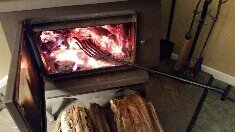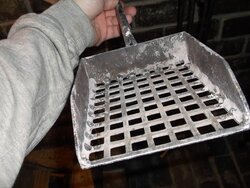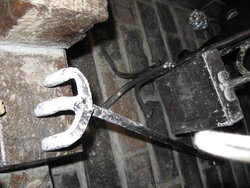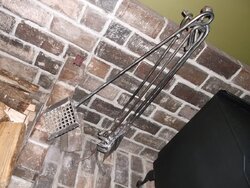Poindexter...100% stainless. 6" forks, 1/2" spacing. Radius to cup coals...sides would be great. 30" handle. Made entirely of cut off materials.
I have paid for one of my kids to go to welding college for four years now, and I gave her cat (
Felis domesticus) a good home while she was away. She is a certified welding inspector (six G?) and wouldn't weld SS for me for cash money. I'm going to have to make do with maybe cold rolled plain steel when I get my forge running in the summer.
Imma guessing most BK owners don't have the hookup to get custom SS pieces (I sure don't) or a wife (and neighbors) that let them run a smithy in the back yard.
Summer of 2014 my woodpile looked like trailer trash, but I put 9 cords in the shed at 12-16%MC and came up with the coal sorter on the left. I was hot loading every 12 hours, burning down my coals in about two hours every Saturday and keeping coals from lemon seed up to table grape size so I could reload without kindling and matches. The only problem I had last year with the tool on the left was the wires are too wide, the holes are about right.
This year (18%MC average in the woodpile) I am still loading every 12 hours, burning down coals for two hours DAILY and shoveling out ashes twice weekly. I came up with the tool on the right a couple days ago to deal with baseball to golf ball sized coals, the rest go away. I can say my woodpile looked "nicer" over the summer of 2015, but it hasn't proven to be worth it; I have burnt one cord this year, eight to go.
The manual for the A30 specifies 13% MC and I am living the difference.
Only +25dF here tonight, I hope to be free of stack effect pretty soon, looking for -10dF Thursday night.
Looking forward to Black Friday. I issued the "Poindexter Challenge" in last year's BK performance thread for folks to bring a couple days worth of wood into their furnace room, dry it down to 13% and try the difference on Black Friday.
Look y'all, it is all very nice for BKVP Chris to say "anything up to 22%MC is OK" and we all know the EPA test ran on crib wood in that range- so our emissions numbers are believable. But the owners manual for the A30 says 13%MC plain as day - and it makes a difference.
How much of a difference depends on how hard you are running the stove. At nine cords per year in one stove, I am running it hard and this sucks. Last year I was spending maybe 30 minutes daily on the stove and the humidifier and the distiller we got to make distilled water for the humidifier. I am at an hour daily now, 2.5 months into a 9 month burn season. 30 wasted minutes a day x nine months, holy cow, I don't even want to do the math.





